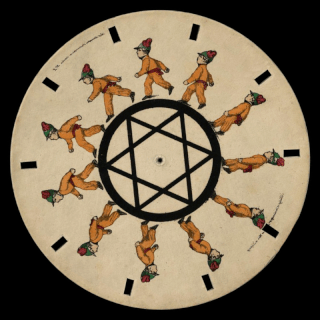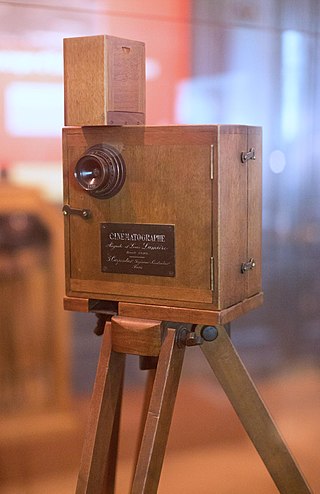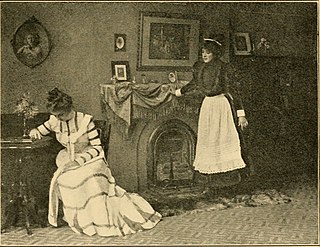Related Research Articles

The magic lantern, also known by its Latin name lanterna magica, was an early type of image projector that used pictures—paintings, prints, or photographs—on transparent plates, one or more lenses, and a light source. Because a single lens inverts an image projected through it, slides were inserted upside down in the magic lantern, rendering the projected image correctly oriented.

The phenakistiscope was the first widespread animation device that created a fluid illusion of motion. Dubbed Fantascope and Stroboscopische Scheiben by its inventors, it has been known under many other names until the French product name Phénakisticope became common. The phenakistiscope is regarded as one of the first forms of moving media entertainment that paved the way for the future motion picture and film industry. Similar to a GIF animation, it can only show a short continuous loop.

A slide show, or slideshow, is a presentation of a series of still images (slides) on a projection screen or electronic display device, typically in a prearranged sequence. The changes may be automatic and at regular intervals or they may be manually controlled by a presenter or the viewer. Slide shows originally consisted of a series of individual photographic slides projected onto a screen with a slide projector, as opposed to the video or computer-based visual equivalent, in which the slides are not individual physical objects.

Precursors of film are concepts and devices that have much in common with the later art and techniques of cinema.

James Wallace Black, known professionally as J.W. Black, was an early American photographer whose career was marked by experimentation and innovation.

Miss Jerry is an 1894 American feature-length black-and-white silent pre-film "Picture Play" written and produced by Alexander Black and starring Blanche Bayliss. Miss Jerry was not a film, but a series of posed magic lantern slides projected onto a screen with a dissolving stereopticon, accompanied by narration and music, making it the first example of a feature-length dramatic fiction on screen.
Articles related to the field of motion pictures include:

A projector or image projector is an optical device that projects an image onto a surface, commonly a projection screen. Most projectors create an image by shining a light through a small transparent lens, but some newer types of projectors can project the image directly, by using lasers. A virtual retinal display, or retinal projector, is a projector that projects an image directly on the retina instead of using an external projection screen.

The history of film technology traces the development of techniques for the recording, construction and presentation of motion pictures. When the film medium came about in the 19th century, there already was a centuries old tradition of screening moving images through shadow play and the magic lantern that were very popular with audiences in many parts of the world. Especially the magic lantern influenced much of the projection technology, exhibition practices and cultural implementation of film. Between 1825 and 1840, the relevant technologies of stroboscopic animation, photography and stereoscopy were introduced. For much of the rest of the century, many engineers and inventors tried to combine all these new technologies and the much older technique of projection to create a complete illusion or a complete documentation of reality. Colour photography was usually included in these ambitions and the introduction of the phonograph in 1877 seemed to promise the addition of synchronized sound recordings. Between 1887 and 1894, the first successful short cinematographic presentations were established. The biggest popular breakthrough of the technology came in 1895 with the first projected movies that lasted longer than 10 seconds. During the first years after this breakthrough, most motion pictures lasted about 50 seconds, lacked synchronized sound and natural colour, and were mainly exhibited as novelty attractions. In the first decades of the 20th century, movies grew much longer and the medium quickly developed into one of the most important tools of communication and entertainment. The breakthrough of synchronized sound occurred at the end of the 1920s and that of full color motion picture film in the 1930s. By the start of the 21st century, physical film stock was being replaced with digital film technologies at both ends of the production chain by digital image sensors and projectors.

Barrier-grid animation or picket-fence animation is an animation effect created by moving a striped transparent overlay across an interlaced image. The barrier-grid technique originated in the late 1890s, overlapping with the development of parallax stereography (Relièphographie) for 3D autostereograms. The technique has also been used for color-changing pictures, but to a much lesser extent.

Alexander Black (1859–1940) was an American author, photographer, newspaper man, and the inventor of the pre-cinema “Picture Play” which debuted in 1894.
Lauritz Carl Constantin Philipsen is credited as one of the founders of the Cinema of Denmark.

Cecil Victor Shadbolt was a British photographer, who pioneered aerial photography from flying balloons.
For the history of animation after the development of celluloid film, see history of animation.
Events in 1892 in animation.
Events in 1883 in animation.
Events in 1882 in animation.
Events in 1872 in animation.
Events in 1866 in animation.
Events in 1862 in animation.
References
- ↑ Mannoni, Laurent The Great Art of Light and Shadow (2000 translation by Crangle)
- ↑ Askari, Kaveh (2015). Making Movies Into Art: Picture Craft from the Magic Lantern to Early Hollywood. Palgrave MacMillan. p. 24.
- ↑ "Photography in Fiction". Cornell University. Retrieved 2007-03-18.
- ↑ Alexander Black (September 1895). "Photography in Fiction". Scribners. Vol. 18, no. 3. Retrieved 2010-02-25.
- ↑ Ramsaye, Terry (1926). A Million and One Nights: A History of the Motion Picture. Simon & Schuster, New York.
- ↑ p. 182 Thomas, Alastair H. Historical Dictionary of Denmark Rowman & Littlefield, 26 Jul. 2016
- ↑ p. 172 Abel, Richard Encyclopedia of Early Cinema Taylor & Francis, 2005
- ↑ "Constantin Philipsen".
- ↑ "The Shadbolt Collection" . Retrieved 27 April 2020.
- ↑ Colin, Fenn (2016). "George & Cecil Shadbolt – Pioneer Photographers" (PDF). Friends of West Norwood. Newsletter (86): 6–8.
- ↑ "Cecil Shadbolt (left) and 'Captain' William Dale (right)..." Historic England. Retrieved 27 April 2020.